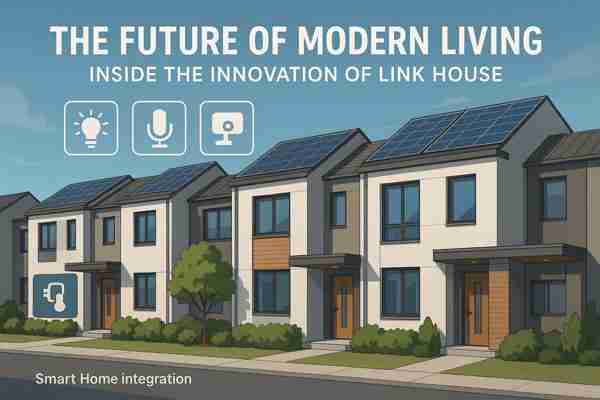
In a world where urban development continues to expand, the concept of smart, flexible, and sustainable housing is gaining rapid momentum. One architectural and real estate trend leading this evolution is the Link House — a transformative housing solution that blends design efficiency, connectivity, and comfort. Whether you’re a homebuyer, real estate investor, or architecture enthusiast, understanding the concept of a Link House is crucial to recognizing its value in the future of modern living.
What is a Link House?
A Link House is a type of residential unit that shares at least one wall with an adjacent unit, typically designed in rows or clusters. Unlike detached houses, Link Houses offer a cost-effective housing solution without sacrificing privacy or functionality. What sets them apart is their innovative architecture that “links” living spaces without making them feel crowded or congested.
Architectural Design of Link Houses
The architectural layout of Link Houses is built on the principle of space optimization. These homes often include open floor plans, multi-level layouts, and minimalist design elements to create an illusion of space and depth. High ceilings, large windows, and strategic wall placements ensure natural light penetration and ventilation, making the environment both energy-efficient and aesthetically pleasing.
Furthermore, many Link Houses incorporate modular construction techniques that make them easier and faster to build. These methods are not only cost-saving but also reduce construction waste, contributing to a sustainable housing ecosystem.
Smart Home Integration
One of the most attractive features of modern Link Houses is the incorporation of smart home technology. These homes are often equipped with:
- Automated lighting systems
- Voice-activated assistants
- Smart thermostats
- Security surveillance systems
With these technologies, residents can control nearly every aspect of their home remotely. The inclusion of Internet of Things (IoT) devices allows for enhanced security, energy conservation, and convenient living.
Cost Efficiency and Affordability
In today’s volatile housing market, affordability is key. Link Houses strike the perfect balance between cost and comfort. Because they share infrastructure such as walls, plumbing, and electrical systems, the cost of construction and maintenance is significantly lower compared to detached houses.
This makes Link Housing developments a smart choice for:
- First-time homebuyers
- Young families
- Real estate investors
- Retirees seeking low-maintenance living
Their relatively smaller footprint also means lower utility bills and property taxes, making them an economically viable option.
Sustainability and Green Living
Sustainability is no longer optional—it’s a necessity. Link Houses often come equipped with eco-friendly features such as:
- Rainwater harvesting systems
- Solar panels
- Energy-efficient appliances
- Sustainable building materials
The compact design reduces energy consumption, and the integration of green technologies supports low-carbon living. Many Link House communities are designed around green belts, community gardens, and parks, promoting a balanced and healthy lifestyle.
Community Living and Connectivity
Despite their compact design, Link Houses often provide strong community connectivity. Shared walls don’t equate to a lack of privacy—instead, they promote a sense of neighborhood belonging. Some Link House developments even include shared amenities like:
- Clubhouses
- Swimming pools
- Play areas for children
- Walking and cycling paths
These shared amenities contribute to social cohesion and foster community engagement. It’s not just about owning a house, but being part of a connected living environment.
Customization and Flexibility
Another major appeal of Link Houses is the level of customization they offer. Builders and architects provide various modular upgrade options to accommodate personal tastes and lifestyle requirements. Whether you need a home office, an extra bedroom, or a rooftop garden, Link Houses are designed to be easily adaptable.
This flexibility makes Link Houses ideal for multi-generational living, remote workers, or growing families.
Urban Planning and Smart Growth
Link Houses also play a key role in urban planning and smart growth. As cities expand, there’s an increasing need to utilize land more efficiently. Link Houses allow for higher population density without the problems often associated with high-rise apartment complexes.
Incorporating them into urban development plans helps reduce urban sprawl, supports public transport infrastructure, and encourages walkable neighborhoods. This aligns perfectly with the goals of sustainable city planning and livable urban environments.
Investment Potential
From an investment perspective, Link Houses are a goldmine. They offer:
- High rental demand
- Low vacancy rates
- Steady appreciation in value
Because of their affordability and popularity among young professionals and small families, Link Houses provide excellent rental yields. Moreover, the growing demand for smart, sustainable homes ensures their value will only increase over time.
Conclusion
The Link House is not just a housing option—it’s a modern lifestyle solution that combines affordability, sustainability, and smart design. It addresses some of the most pressing issues in urban housing, including cost, space, and environmental impact, while offering the comfort and connectivity modern families seek.
As urban centers continue to evolve, Link Houses will play a pivotal role in shaping the future of residential architecture. Whether you’re a buyer, investor, or planner, now is the perfect time to explore the potential of this innovative housing model.
Also Read: How Custom Home Builders in Sydney Bring Your Personalised Designs to Life


